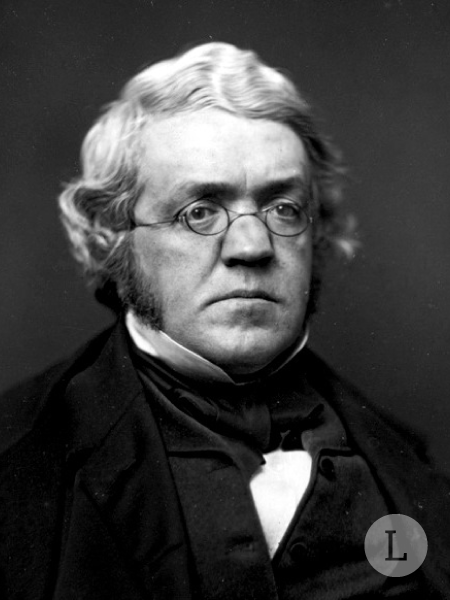
born: JULY 18, 1811
died: DECEMBER 24, 1863
nationality: ENGLISH
movement: VICTORIAN
Delve into the life of William Makepeace Thackeray, one of the most significant novelists of the Victorian era, whose wit and keen observations continue to captivate readers today. Best known for his satirical masterpiece Vanity Fair, Thackeray left an indelible mark on English literature with his penetrating insights into the complexities and hypocrisies of society.
EARLY LIFE AND EDUCATION
William Makepeace Thackeray was born on July 18, 1811, in Calcutta, British India, to a prosperous Anglo-Indian family. His father, Richmond Thackeray, worked for the British East India Company, while his mother, Anne Becher, was the daughter of a prominent civil servant.
After his father’s death in 1815, Thackeray was sent to England to live with his aunt and receive his education. He attended several schools, including the prestigious Charterhouse School, which he later satirized in his works. Thackeray then went on to study at Trinity College, Cambridge, but left the university without obtaining a degree.
CAREER AND LITERARY SUCCESS
Thackeray’s early career was marked by financial struggles and personal hardships. He initially pursued a career in law and art before turning to journalism as a means of supporting himself. He began contributing to various magazines and periodicals, adopting numerous pseudonyms to protect his identity.
Thackeray gained literary recognition with the publication of Vanity Fair (1847-1848), a satirical novel that mercilessly depicted the hypocrisies and pretensions of Victorian society. He continued to write novels, short stories, and essays throughout his career, establishing himself as a prominent literary figure of the 19th century.
TOP 10 BOOKS BY WILLIAM M. THACKERAY
Vanity Fair (1847-1848)
Thackeray’s most famous work, this satirical novel follows the lives of Becky Sharp and Amelia Sedley, two young women navigating the treacherous social landscape of early 19th-century England.
The Luck of Barry Lyndon (1844)
A picaresque novel that chronicles the life and adventures of an Irish rogue and opportunist as he seeks to rise through the ranks of 18th-century European society.
Pendennis (1848-1850)
A semi-autobiographical bildungsroman that traces the life of Arthur Pendennis, a young man from the English provinces seeking fame and fortune in London’s literary world.
The History of Henry Esmond (1852)
A historical novel set in the early 18th century, following the life of Henry Esmond, a gentleman soldier and writer, as he becomes embroiled in political intrigues and personal rivalries.
The Newcomes (1853-1855)
A satirical novel that explores the lives of the Newcome family, members of the rising British middle class, as they navigate the complexities of social status and relationships.
The Virginians (1857-1859)
A sequel to The History of Henry Esmond, this novel follows the lives of Henry Esmond’s grandsons, George and Harry Warrington, during the American Revolution.
The Adventures of Philip (1861-1862)
A sequel to Pendennis, this novel follows the life of Philip Firmin, the illegitimate son of a London doctor, as he seeks love and success amidst personal and professional challenges.
Roundabout Papers (1860-1863)
A collection of essays, sketches, and short stories that Thackeray wrote for the Cornhill Magazine, offering his observations on society, politics, and literature.
Catherine (1839-1840)
A satirical novella that parodies the popular Newgate novels of the time, focusing on the life and exploits of the notorious criminal Catherine Hayes.
Men’s Wives (1852)
A collection of three novellas that examine the relationships between men and women, often with a satirical and critical eye on the conventions of marriage and society.
INTERESTING FACTS FROM WILLIAM M. THACKERAYS’S LIFE
- Thackeray was a lifelong friend and literary rival of Charles Dickens, with the two authors often compared and contrasted by contemporary critics and readers.
- He was an accomplished illustrator and often provided his own illustrations for his works.
- Thackeray’s experiences of bankruptcy and financial struggle in his early life influenced many of his novels, which often explored themes of social mobility and wealth.
- He wrote under numerous pseudonyms throughout his career, including George Fitz-Boodle, Michael Angelo Titmarsh, and Théophile Wagstaff.
- Thackeray’s daughter, Anne Isabella Thackeray Ritchie, was also a successful writer in her own right, known for her biographies, essays, and novels.
AWARDS & HONORS
While Thackeray did not receive many awards during his lifetime, his works have been recognized and celebrated posthumously. Some notable honors and tributes include:
- In 1860, Thackeray was elected to the prestigious Athenaeum Club, a London-based club for individuals distinguished in literature, art, and science.
- A blue plaque, commemorating Thackeray’s life and work, is located at his former London residence at 2 Palace Green.
- The University of Calcutta, in recognition of Thackeray’s literary achievements, established the William Makepeace Thackeray Chair of English Literature in 2007.
William Makepeace Thackeray’s sharp wit, keen observations, and engaging narratives have ensured his place as one of the most significant and celebrated authors of the 19th century.
DEATH AND TIMELESS LEGACY
William Makepeace Thackeray passed away on December 24, 1863, at the age of 52, after suffering a stroke. He was buried at Kensal Green Cemetery in London.
Thackeray’s legacy is one of critical and satirical insight into the complexities and hypocrisies of Victorian society. His works, particularly Vanity Fair, continue to be celebrated and studied for their wit, characterization, and social commentary. Thackeray’s influence can be seen in the works of later authors, including George Orwell, who admired his keen observations of human nature and society.
